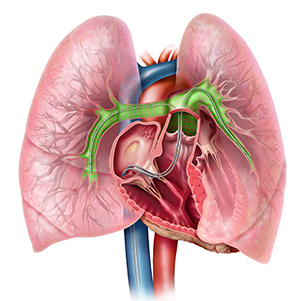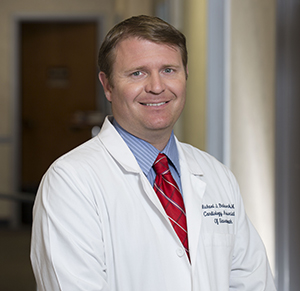The Heart Hospital uses the latest technology to treat PE clots
Heart Health
The EkoSonic Endovascular System’s sophisticated catheter and ultrasonic core effectively target blood clots
Blood clots can be helpful to stop bleeding after you prick a finger or scrape a knee, but they also can be very dangerous when they form in the heart, lungs or brain. This can lead to heart attack, stroke or other serious medical condition.
One such condition that can start in the lungs and lead to heart failure is pulmonary embolism (PE). A pulmonary embolism is a blood clot that forms within the body and travels to the lung. When this occurs, it blocks the ability of blood to flow to the lungs and presents a dangerous situation. Since the right side of the heart pumps blood to the lungs, a backup of blood flow puts strain on the heart causing heart failure, explains Dr. Michael Babcock, interventional cardiologist with Cardiology Associates of Savannah who practices at The Heart Hospital at St. Joseph’s/Candler.

The blood clots that cause PE usually form in the deep veins of the legs (a condition called deep vein thrombosis or DVT), break free and travel to the lungs. Part of the lungs’ job is to filter out blood clots; however, the larger the clot, the less likely the lung can dispose of it.
“Large blood clots can acutely obstruct all blood flow to the lungs, which can be life threatening,” says Dr. Babcock.
Symptoms of blood clots include:
- Shortness of breath
- Progressively worsening chest pain
- Cough
- Rapid or irregular heartbeat
- Excessive sweating and dizziness
Blood clots can happen to anyone at any age. They can be a result of immobility following a recent surgery or long distance traveling. Certain medical conditions, such as cancer or certain blood disorders, can predispose people to DVT blood clots, Dr. Babcock says.
Up to 900,000 people in the United States are affected by blood clots each year, according to the National Blood Clot Alliance. About 100,000 of those die, which is greater than the total number of people who die from AIDS, breast cancer and motor vehicle crashes combined.
Treatment of PE blood clots
Blood clots can be managed and prevented in a variety of ways, most commonly with anticoagulants, or blood thinners. However, in emergency situations, such as a stroke, or for patients with massive or submassive PE blood clots, thrombolytic therapy may be necessary. Thrombolytic drug therapy involves the use of medication to dissolve blood clots.
Related Article: Who should take blood thinners
Recent advances in technology have greatly improved the outcomes and recovery times of patients who need thrombolytic therapy. An advanced tool used at The Heart Hospital by Dr. Babcock is the EkoSonic Endovascular System, which uses targeted ultrasonic waves in combination with clot-dissolving drugs. The system uses a sophisticated catheter and an ultrasonic core to effectively target an entire clot.
“They have found now if we can take a catheter and deliver that medication directly into the lungs and into the blood clot, we can use a fraction of the amount of medication and it’s delivered right where it needs to be so it doesn’t have as much systemic effect,” Dr. Babcock says.

This minimally-invasive procedure is performed in the cath lab at The Heart Hospital, and patient care is carefully coordinated with critical care physicians. An infusion catheter is inserted first via a vein in the leg, followed by the ultrasonic core, Dr. Babcock explains. The catheter wire is thread through the heart and lungs to the site of the blood clot.
The core has very small ultrasonic heads within it, emitting an ultrasonic frequency that loosens the fibrin strains. Fibrin is an insoluble protein formed during the clotting of blood, creating a fibrous mesh that forms blood clots. As the fibrin loosens, the thrombolytic agent (in most cases tPA, or tissue plasminogen activator) penetrates the fibrin, dissolving the blood clot.
“The whole premise is we have rapid resolution of the clot, people feel better very quickly and they are able to get out of the hospital quickly and back to their families,” Dr. Babcock says. “The patient benefits from rapid stabilization, lower bleeding risks and decreased oxygen demand.”
Preventing blood clots
Blood clots can be dangerous, but they also can be prevented in most people. Steps you can take to reduce your chances of forming blood clots are:
- Know your risk for blood clots. Talk to your doctor, especially if you have a family history of blood clots.
- Recognize the signs and symptoms of blood clots.
- Before any surgery, talk to your doctor about your risks of blood clots.
- Be active, especially if you’ve been sitting for a long time or traveled for a long time by plane, train or car. Try to stand up, walk around and stretch every two to three hours.
- Maintain a healthy weight.
- Quit smoking if you do so.
To learn more about Dr. Babcock and Cardiology Associates of Savannah, visit their website. For more information on The Heart Hospital, click here.
For more information on EKOS therapy, visit ekoscorp.com.
Top photo courtesy of EKOS Corporation